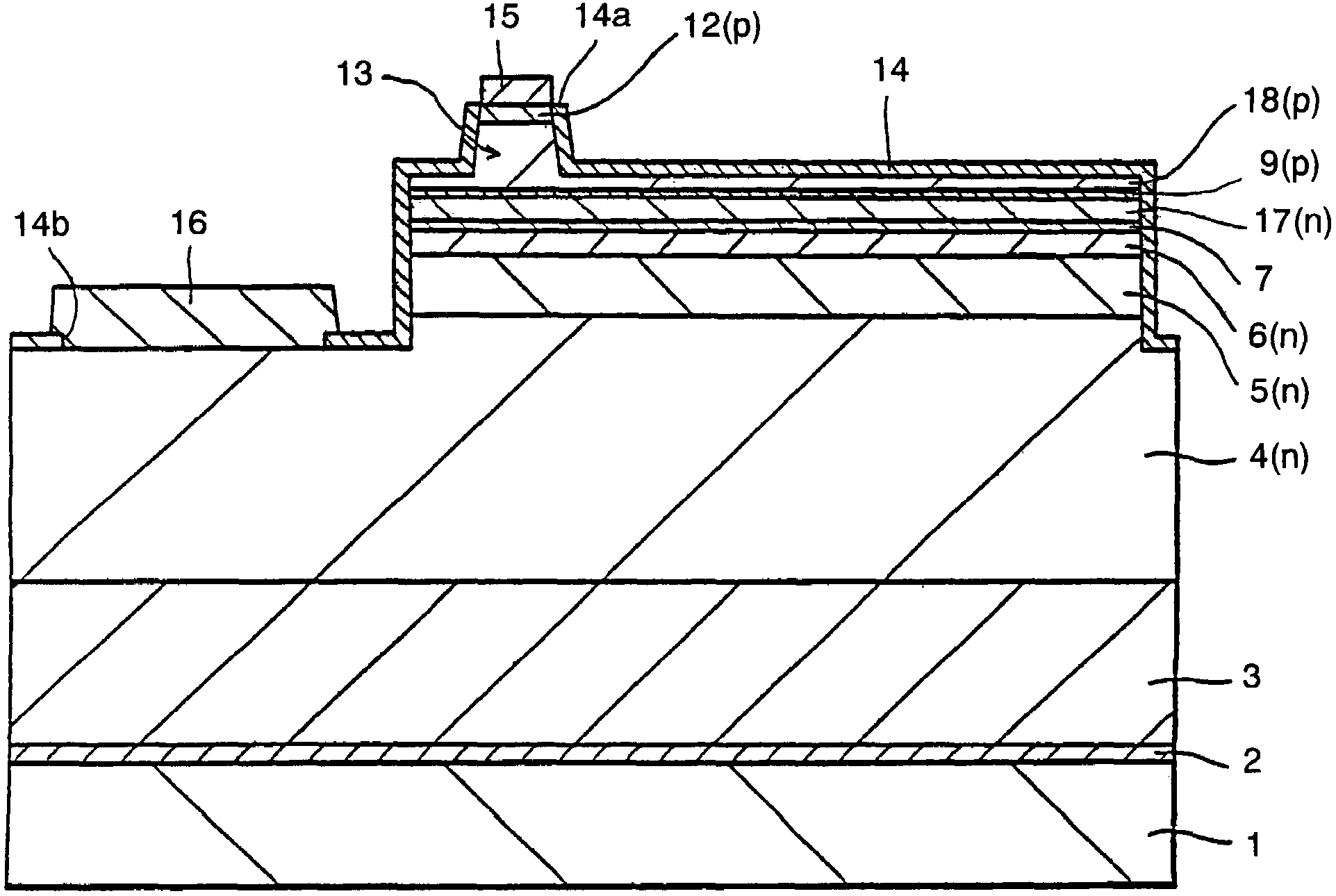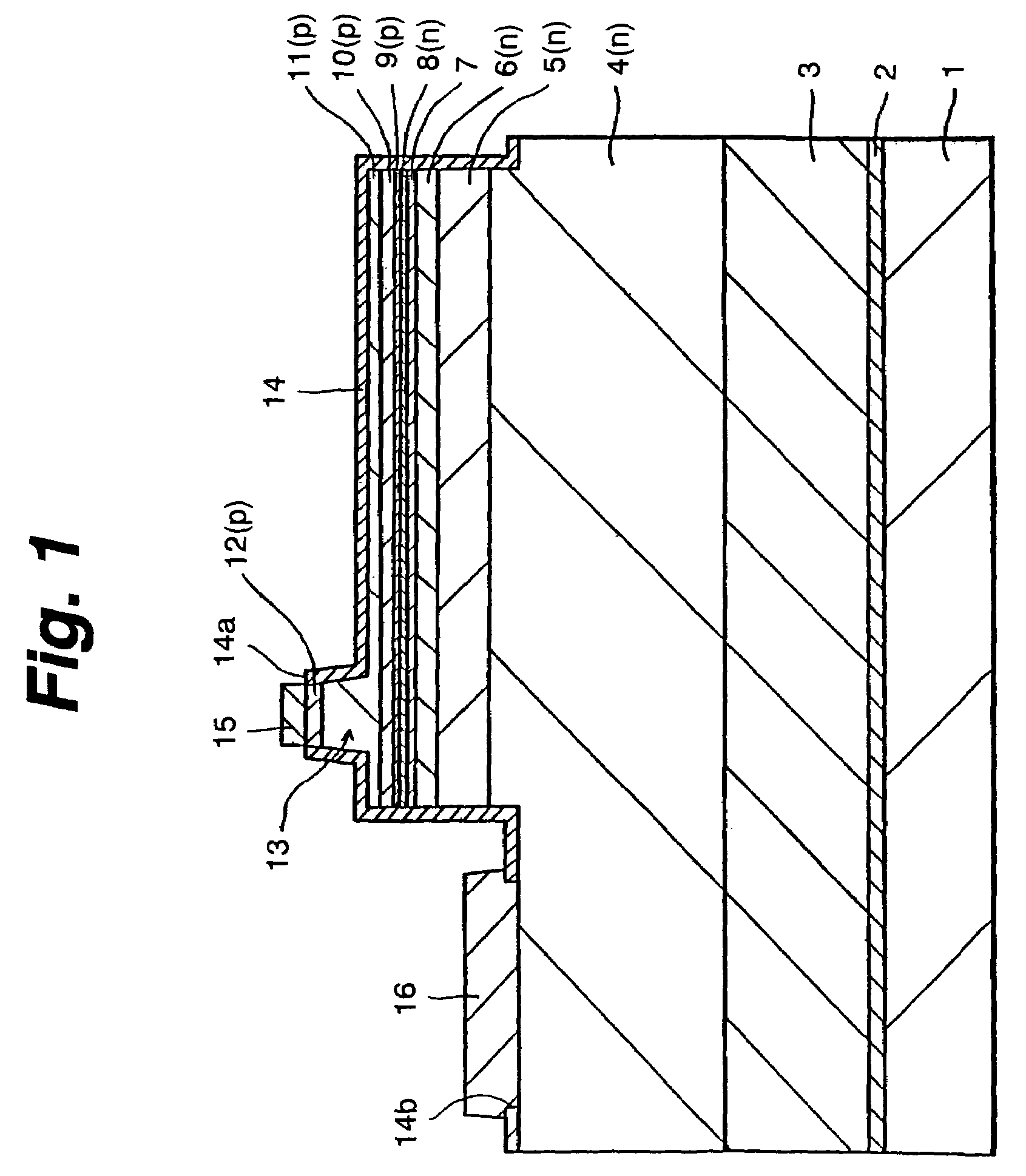Semiconductor light emitting device, its manufacturing method, semiconductor device and its manufacturing method
a technology of semiconductors and light emitting devices, applied in the direction of lasers, nanoinformatics, semiconductor lasers, etc., can solve the problems of large stress generation in the active layer, deterioration deterioration of the active layer, etc., to achieve good crystalline quality, improve the effect of thickness and reduce the stress
- Summary
- Abstract
- Description
- Claims
- Application Information
AI Technical Summary
Benefits of technology
Problems solved by technology
Method used
Image
Examples
first embodiment
[0257]FIG. 1 shows a GaN compound semiconductor laser according to the invention. This GaN compound semiconductor laser has a ridge structure and a SCH (separate confinement heterostructure) structure.
[0258]As shown in FIG. 1, the GaN compound semiconductor laser according to the first embodiment includes an undoped GaN layer 3 grown by lateral crystal growth technique such as ELO: n-type GaN contact layer 4; n-type AlGaN clad layer 5; n-type GaN optical guide layer 6; active layer 7 having an undoped InxGa1-xN / InyGa1-yN multiquantum well structure, for example; n-type undoped InGaN deterioration preventing layer 8; p-type AlGaN cap layer 9; p-type GaN optical guide layer 10; p-type AlGaN clad layer 11; and p-type GaN contact layer 12 that are sequentially overlaid on a c-plane sapphire substrate 1 via an undoped GaN buffer layer 2 grown at a low temperature.
[0259]The undoped GaN buffer layer 2 is 30 nm thick, for example. The undoped GaN layer 3 is 0.5 μm thick, for example. The n-...
second embodiment
[0281]Next explained is a GaN compound semiconductor laser according to the invention. FIG. 3 is an energy band diagram of this GaN compound semiconductor laser.
[0282]In the GaN compound semiconductor laser according to the second embodiment, Indium composition in the undoped InGaN deterioration preventing layer is uniform throughout the entire thickness thereof, and the indium composition is adjusted to a value smaller than the Indium composition y of the barrier layers in the active layer 7, namely 0.02, for example. In the other respects, its structure is identical to that of the GaN compound semiconductor laser according to the first embodiment. So, its explanation is omitted here.
[0283]This GaN compound semiconductor laser can be manufactured by the same method as that of the GaN compound semiconductor laser according to the first embodiment except that the undoped InGaN deterioration preventing layer 8 is grown under a constant growth temperature.
[0284]The second embodiment al...
third embodiment
[0285]Next explained is a GaN compound semiconductor laser according to the invention. FIG. 4 is an energy band diagram of this GaN compound semiconductor laser.
[0286]In the GaN compound semiconductor laser according to the third embodiment, Indium composition of the undoped InGaN deterioration preventing layer is uniform throughout the entire thickness thereof, and the indium composition is adjusted to the same value as the Indium composition y of the barrier layers in the active layer 7. Thickness of the undoped InGaN deterioration preventing layer 8 is adjusted such that the sum of its own thickness and the thickness of one of the barrier layers of the active layer 7 nearest thereto is at least 15 nm, preferably not thinner than 17 nm, more preferably not thinner than 20 nm, or still more preferably not thinner than 25 nm. In the other respects, its structure is identical to that of the GaN compound semiconductor laser according to the first embodiment. So, its explanation is omi...
PUM
| Property | Measurement | Unit |
|---|---|---|
| thickness | aaaaa | aaaaa |
| thickness | aaaaa | aaaaa |
| thickness | aaaaa | aaaaa |
Abstract
Description
Claims
Application Information
 Login to View More
Login to View More - R&D
- Intellectual Property
- Life Sciences
- Materials
- Tech Scout
- Unparalleled Data Quality
- Higher Quality Content
- 60% Fewer Hallucinations
Browse by: Latest US Patents, China's latest patents, Technical Efficacy Thesaurus, Application Domain, Technology Topic, Popular Technical Reports.
© 2025 PatSnap. All rights reserved.Legal|Privacy policy|Modern Slavery Act Transparency Statement|Sitemap|About US| Contact US: help@patsnap.com



